
Shimomaruko station.
[ <<previous | index | next >> ]
20:27
I slept well, but woke just after 06:00, with the dim grey dawn light just poking through the window curtains. The view from my window is quite spectacular, looking north-east over Yokohama harbour from the ninth floor. I tried to sleep in a bit more, but actually started waking up, so I got up and began preparing for the day. I had to find my way to Kamata, and asked at the front desk again how to get there. The man gave me a very useful map of the local area, including Minatomirai station, the nearest one to walk to, and Yokohama station, where I had to change to a JR train to Kamata. I also asked if I could buy a Suica card at Minatomirai, and the guy said yes.
So I rugged up in my coat and the scarf M. had left behind in San Francisco, to brave the cold morning air and walk to the station. The temperature here was much colder than it had been in San Francisco, hovering around the 5°C mark. It took a few minutes to get my bearings, but I eventually found the right street to walk down and then found the station. I bought a Suica card at a ticket machine, then hopped on the train to Yokohama. This first train was fairly empty, and I thought maybe I'd be lucky and avoid any crowds. But Yokohama station was big and frantic with thousands of people rushing to and fro in their morning commutes. My main worry was that the Suica card came with just 500 yen on it and I had used 180 of that on the two-station trip from Minatomirai to Yokohama. I wasn't sure if the remainder was even enough to get me to Kamata, let alone on to Shimomaruko.
 Shimomaruko station. |
I wanted to add some extra cash to the card, but couldn't figure out how to do it on the machines, despite mastering it on my last trip to Tokyo a few years ago. There was a manned ticket office of sorts, but on questioning, the old man there spoke no English. I managed to get across that I wanted to go to Kamata, and he scanned my Suica card and wrote down a platform number and time for me. I used gestures to try to ask if the card had enough credit on it, and he nodded yes. So I entered the JR ticket barriers and hoped he was right.
He was, as the barriers at Kamata let me out, after a squashy train ride the seven or so stops north from Yokohama station. The train was pretty full when I got on, and just got fuller and fuller as we headed towards Tokyo. I had to push my way through the massed bodies to get off at Kamata. But now the credit on my Suica card was perilously low, and I tried again fruitlessly to work out how to add more credit to it, through the cryptic partial English on the ticket machines. I found a JR employee who spoke enough English to assist me in pushing the non-obvious buttons on the ticket machine, and he helped me add another 500 yen, which as it turned out was enough to get me to Shimomaruko, and then all the way back to Minatomirai when I returned later.
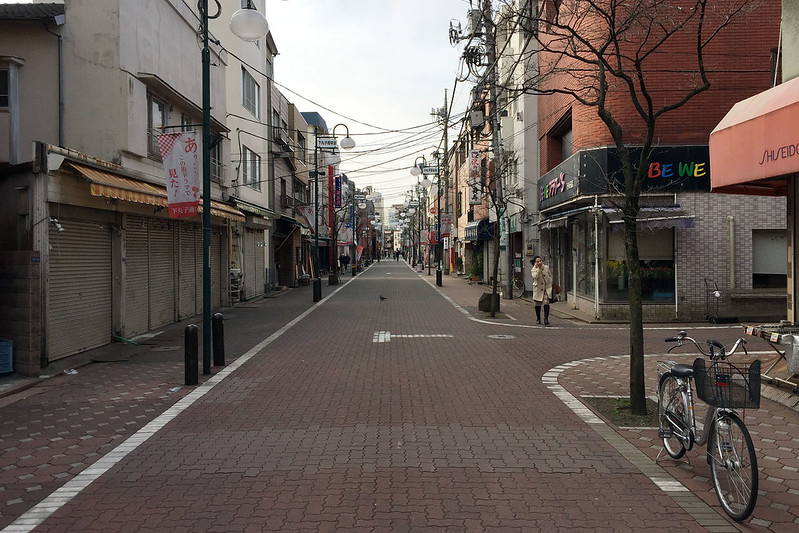 Shimomaruko street. |
At Shimomaruko I was on familiar ground, and walked to a 7-11 store near the station to finally buy some breakfast, and also to withdraw some cash from the ATM there. I got two patties of sushi rice, one with salmon or something inside and crisp nori sheets outside, and one wrapped in omelette and with tomato in the rice, as well as a pastry bun thing with sultanas and orange peel in it, which was nice. I ate them in the tiny park not far away, where I've eaten similar meals before, before continuing my walk to the Canon headquarters.
Entering the security gate and showing my work ID to get a visitor badge, I went to building A to await my meeting with Nagata-san, to discuss some of the ISO standards which will be the topics of the international meeting this week. This meeting was over by 10:30, so I rode the trains back to my hotel and dropped off my laptop in exchange for my camera, then went out again to find some lunch and do some exploring of Yokohama.
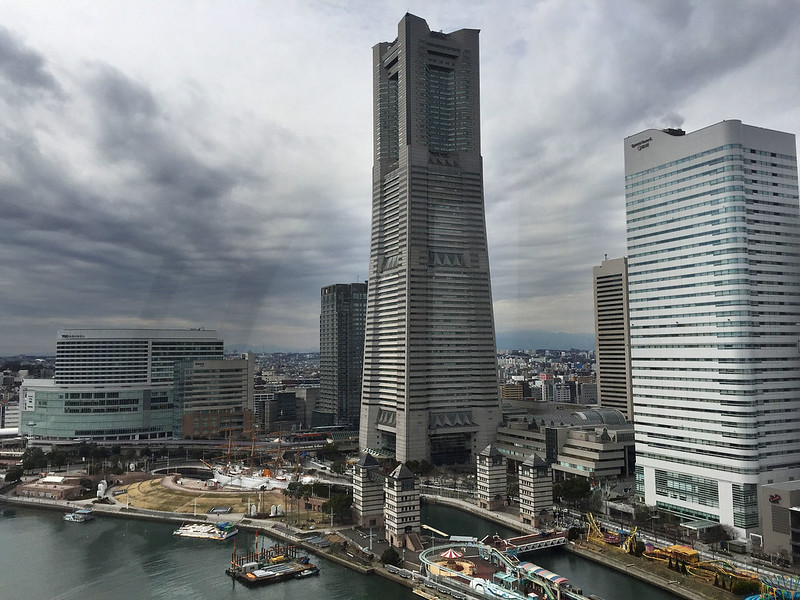 View from Cosmo Clock 21, Yokohama Landmark Tower at centre. |
My first stop was actually the nearby amusement park, where there is a spectacularly huge Ferris wheel, just a tiny bit smaller than the size of the London Eye, if not bigger. It has the odd name of Cosmo Clock 21. (Later research revealed Cosmo Clock 21 is 112 metres high, compared to the London Eye's 135 metres.) I paid 800 yen for a ride, and got some spectacular views. The wheel is in a small amusement park complex which contains a large roller coaster, a couple of smaller ones, a flume ride, and a bunch of sideshow amusements and games. One odd thing is a section with a sign labelled "Burano", which contains a row of what look like small Italian houses from the outside, painted in different colours just like the houses of the island of Burano near Venice.
After this I walked across a bridge to the World Porters shopping centre, to get some lunch. I found a sushi place which had plates going around on a conveyor belt, and also an ordering system where you could request specific sushi freshly made. A waitress gave me a set of laminated instructional pages in English, which was helpful, and I ordered four plates of the most interesting looking things, then grabbed another plate off the conveyor when I'd finished most of those and realised I could eat a little more.The waitress also brought a complimentary bowl of miso soup, which had a chunk of fish in it. I tried eating this, only to discover it was full of large bones, so spent the next minute pulling them out of my mouth. The sushi was all good.
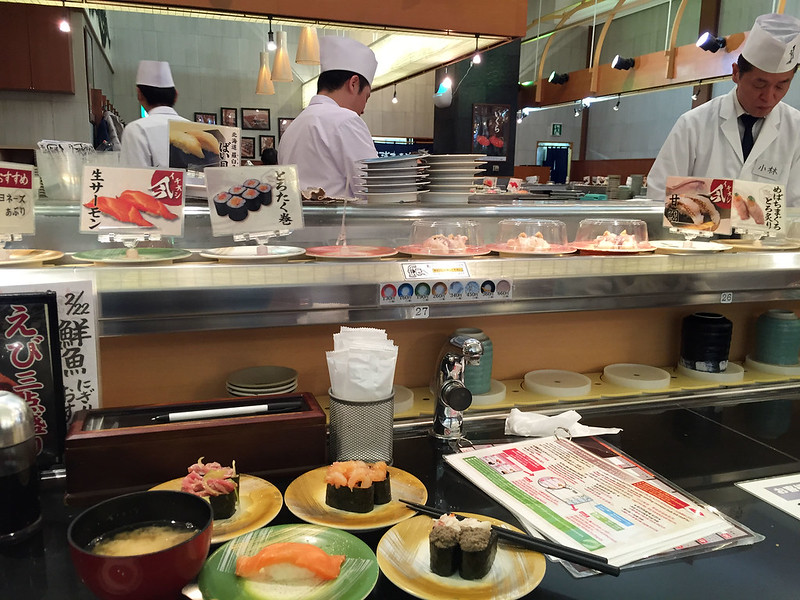 Sushi lunch, World Porters shopping centre. |
On the way out of the shopping centre, I passed an ice cream place, and it looked good so I got a couple of flavours to try. One was fondant chocolate, like I had in Sapporo, though this one wasn't quite as thick and rich, but still good. The other flavour had no English label, so I just pointed at it. It was a sort of straciatella with chunks of strawberry in it, also good.
Outside the building, my ears were assailed by an incredible loud noise, which turned out to be music being played from huge speakers in a small van parked on the side of the road. I don't know what they were doing specifically, because there didn't appear to be any crowd or special event happening. It was just two guys parked on the street with the back panel of the van opened up to reveal four enormous oversized speaker cones, and thumping out J-pop and other music. It was so loud that it felt too loud to listen to without ear protection even from about fifty metres away.
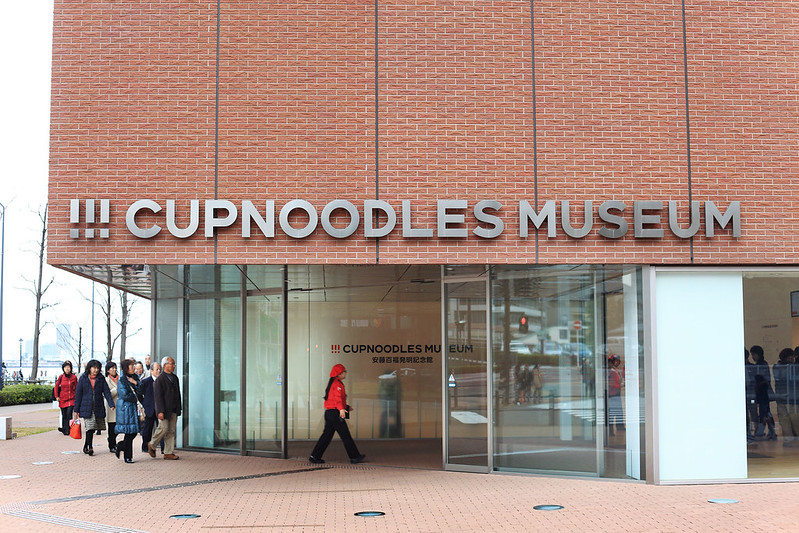 Cup Noodles Museum. |
I crossed over to the waterfront park facing the harbour and walked around there briefly while I finished my ice cream. Then I went to the Cup Noodles Museum, which was right across the road from World Porters. This was just what it sounds like, a museum dedicated to Cup Noodles. Astonishingly, it filled five floors of a custom building, and there were hordes of visitors, including school tour groups, tour groups of adults, and lots of people in smaller groups or alone. It honoured Momofuku Ando, the inventor of instant noodles, which apparently is such a huge cultural icon here In Japan that it can support such a museum. I paid my 500 yen entry fee and was amazed at how much stuff there was inside.
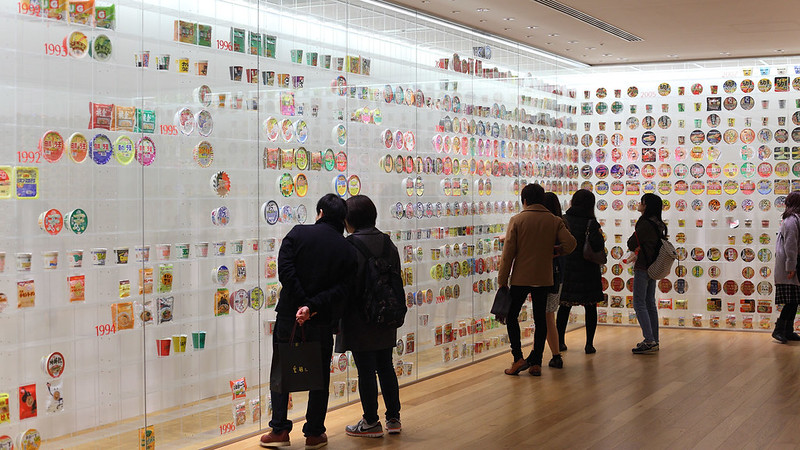 Historic Cup Noodles from every year. |
One floor was a serious historical display telling the story of instant noodles, including a full sized replica of Ando's tiny shack where he first did the experiments that led to instant noodles, a detailed timeline of the development of the product from a one man operation to a giant company, and a display of all the varieties of noodles and packaging over the years. Another floor had the "build your own cup noodle" interactive exhibit, which you had to pay extra for and book a time at the front desk, as it looked to be insanely popular. Basically you make a cup with your own design, then add whatever dried ingredients you want from a supplied list, blending your own flavour from about 6000 possible combinations, then add the dried noodles and seal your cup, to take with you and eat later.
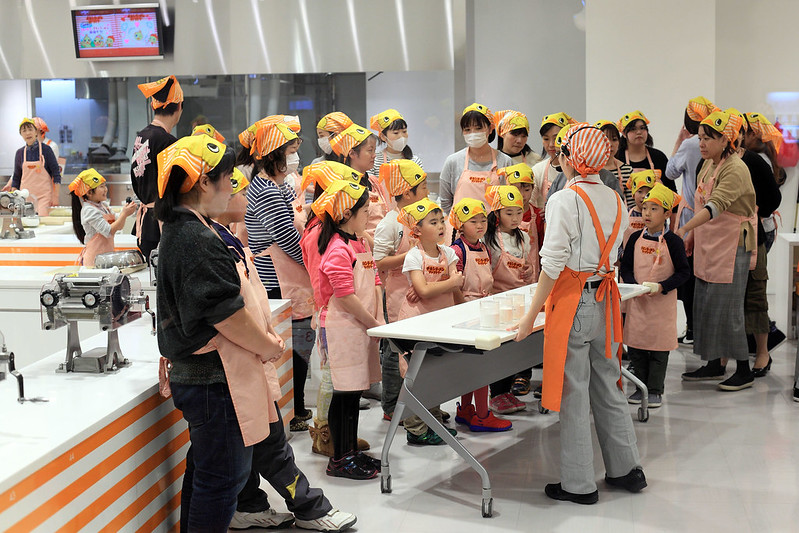 Kids learning how to make noodles. |
On the same floor was a giant kitchen with workbenches for about a hundred people at once. Here you can take a class in how to make your own ramen noodles from scratch, and I watched through the glass wall as a class of young schoolkids began doing a lesson. Another floor had the Cup Noodle play area, with various kiddie activities themed around noodle cups, as well as the "noodles of the world" dining area, which had stalls themed in different nationalities all selling their own particular style of noodles, from Italian pasta to pad Thai, to mee goreng from Indonesia, to cold noodle salad from Korea. And then of course there was the Cup Noodles Museum gift shop, which was doing great business and was so crowded that you had to push your way around it.
After this amazing place, I walked to the historic Red Brick Warehouse, which seems to be an historical warehouse for the nearby docks, but which has been preserved on the outside and filled on the inside with touristy shops and eating places over three long, thin floors. This took some browsing to work through. One place had a window onto a kitchen were a man was making omelettes, taking about 30 seconds to toss the thing in a hot pan and flip it over and then out onto a plate in deft hand movements. Many people watched fascinated, and I took a video.
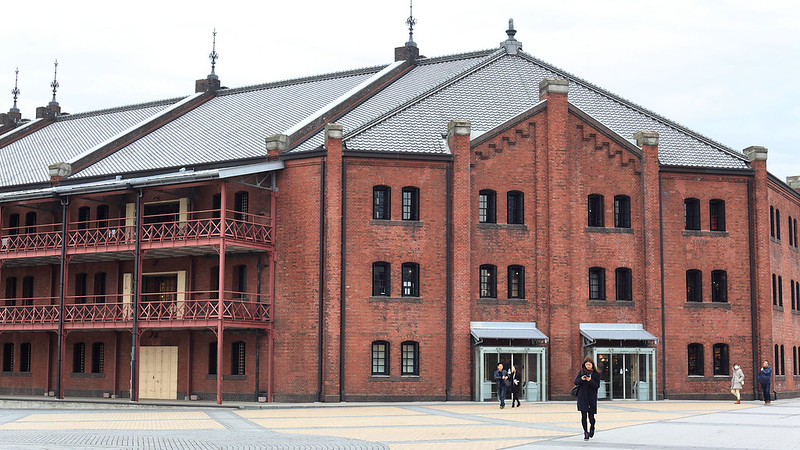 The Red Brick Warehouse. |
From the Red Brick Warehouse, I walked back through World Porters via an elevated pedestrian way, then down on to a promenade which had evidently been converted from an old rail track. This took me past the Nippon Maru, a tall rigged sailing ship, which appears to be permanently berthed as a museum display. I walked on to the Yokohama Museum of Art, figuring I could spend at least an hour and a half or so before 5pm exploring that.
As it turned out, there was no rush, because the museum stayed open until 6pm, and its displayed collection was not very big. When I went in, I had the option of general admission for the permanent collection, or paying a premium for the temporary exhibit. I figured that with not much time I'd better just do the former. This turned out to be only a sculpture area in the large foyer, which included sculptures placed on staggered levels with staircases running up through them to the upper floor, plus four mid-sized gallery rooms. One notable sculpture was a disturbing giant organic shape made of cowhides held together by giant staples, with a vaguely human giant face on one side. One room contained a photography exhibit, with an interesting collection of urban photos in black and white, and some other sets of rural human landscapes in colour.
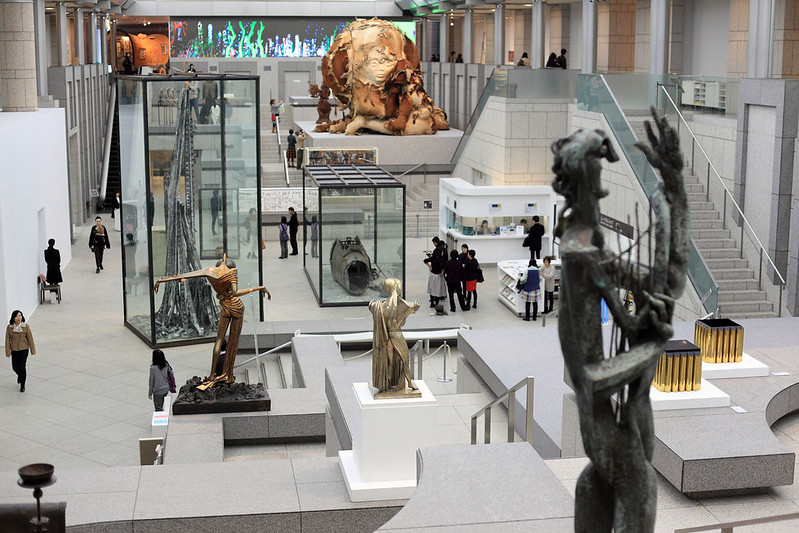 Yokohama Museum of Art. Disturbing cowhide sculpture at top centre. |
Another room held a study of the nude form and its relation to mythology, with a collection of paintings and a few sculptures of scenes from myth and legend with nude figures. A third theme was spread across the last two rooms: "Abstraction and Construction: Images of Industrialisation and the City". This encompassed pieces ranging from pure abstract to constructionist, dadaism, and pop art. It included pieces by Picasso, Kandinsky, Braques, Miro, Warhol, Lichtenstein, as well as a bunch of others, and one of Brancusi's Birds in Space - a golden coloured one, probably brass, on a white marble stand. That was very cool to see. But I exhausted these displays quite quickly before I realised that that was all there was, and so then spent some additional time going back through all the galleries again to have a slower look.
Leaving the art museum, it was starting to sprinkle with a light rain, so I headed back to the hotel, getting under shelter before the rain could get heavy. I had a FaceTime chat with M., who was back home, and then after 6pm went out to brave the cold once again to find a place to have dinner. Wandering through the Queen's Square shopping complex, and then into the Yokohama Landmark Tower, I passed many restaurants, but one on the information boards intrigued me: World Beer Museum.
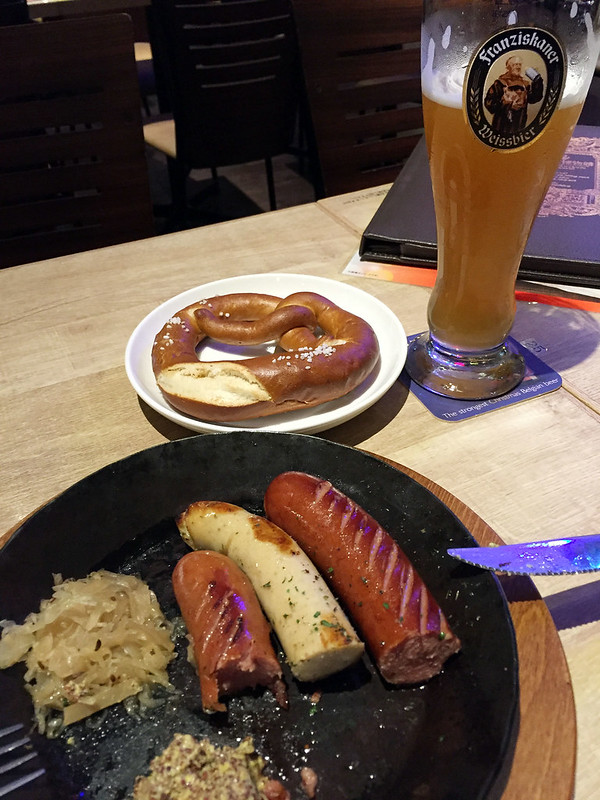 Dinner at the World Beer Museum. |
I found this place after some searching, in a basement level adjacent to the Landmark Tower. It had a lot of restaurant tables, plus five separate bars all decorated in different themes: one an Irish pub, one an American bar, one a German tavern, and so on. I sat at a table and decided to go full on German, since I figured I'd probably be eating a lot of Japanese food during the week. I got a Franziskaner Weissbeer, a sausage plate consisting of three different types of fried sausage with mustard and sauerkraut, and after starting and realising I needed a little more to fill up, a large pretzel. The place had a vast beer list, with hundreds of varieties from all over the world. There must have been 70 or 80 or even more from Belgium alone. There were Mexican beers, Italian beers, Thai beers, Jamaican beers. But the only Australian representative on the list was Victoria Bitter!
After dinner I walked back to the hotel, stopping at a place called Mrs Elizabeth Muffin, where they sold, you guessed it, muffins. I got a chocolate and a banana muffin, eating the chocolate for dessert after I had a shower, and saving the banana for breakfast.
[ <<previous | index | next >> ]